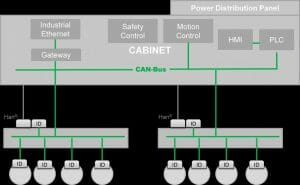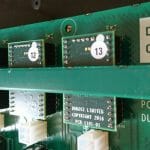HARTING is expanding its range of so-called “smart” connectors which can provide identification of key machine components or functional control elements and are also increasingly being deployed for machinery predictive maintenance. Communication can be performed using inexpensive bidirectional systems like the I2C bus, as well as standardised bus systems such as CAN Bus.
Following on from the already established I2C ID module, the new CAN ID module is the latest product in the smart Han® series. Implementation as a Han-Modular® module ensures that identification is flexibly integrated into interfaces which comprehensively supply machines with power, data and signals, in the most optimum space-saving manner possible.
The progress made by transferring identification functionality to the connector can best be illustrated by showing how such embedded intelligence features can be beneficial to the increasing trends for both modular designed processing machinery and machinery with multiple isochronous drives.
Case 1: ID module in modular designed processing machinery with exchangeable elements (Fig.1)
For modular designed machinery with pluggable drives, auxiliary equipment and other controller units, ID modules help to ensure that each machine module is instantly recognised by the automation control system as it is fitted or replaced, saving machine set-up time and limiting operator error by ensuring that the correct one is applied according to the operational requirements. Information such as the year of manufacturing, the last revision status and other parameters of the machine unit can also be stored and used for predictive maintenance on the application.
The Han-Modular ID module offers the double functionality of an identification tool and data storage device and paves the way for the customisation of the machine unit.
In addition to local machine control, industrial Wi-Fi modules provide easy connection with the Industry 4.0 manufacturing environment.
Case 2: ID module in pluggable isochronous drives (Fig.2)
Both conventional machinery and special-purpose machinery contain machine components characterised by movement processes made up of individual synchronously executing movements.
In conventional machinery, this synchronicity is often achieved by using line shafts, which employ cams and other power couplings to initiate all movements according to a defined process scheme. However, machines with high speeds and accelerated axes are controlled using special sensors, drives and motion controllers. The CAN bus, which operates in real time and is organised according to the “publisher-subscriber” principle, is ideally suited for the synchronisation of subscribers. The CAN ID module also enables the current configuration of the drives to be tested and the parameters that are determined to be transmitted to all other drives and the controller.
The machine may only start up if the drive is correctly configured. Start-up is blocked if any state exists other than the one desired. The benefit for the customer is the potential for time savings, for example during servicing: drive data is available in the module at the periphery, meaning that the revision status can be quickly queried. Individual machine elements can be exchanged and repaired faster, since work on a subsystem does not entail starting the entire machine. This saves time and energy.
As a result, the CAN ID module offers advantages for both types of machinery. On the one hand, it helps implement identification functionality in combination with memory storage capabilities in the device periphery, while on the other it logically complements existing complex systems and helps save time and money on servicing.
For Industry 4.0 applications, integration takes place via network-enabled devices or, in future, directly via an Ethernet interface. This in turn implements end-to-end networking of the data.
About HARTING
The HARTING Group develops, manufactures and distributes electrical and electronic connectors, network components, pre-assembled system cables, and backplane assemblies. These products are capable of withstanding the harshest demands in industrial environments and provide high data rates for electronic applications.
HARTING connectors and network components are used in mechanical engineering and plant manufacturing, in automation systems, energy generation and distribution, and in electronic and telecommunication markets. Industrial connectors are also vital in construction machinery, rail vehicles and shipbuilding. HARTING offers Ethernet network components and cable systems for both indoor and outdoor networking applications involving power and data.
HARTING today employs a workforce of nearly 4200 in 43 countries. For further information visit www.HARTING.co.uk










